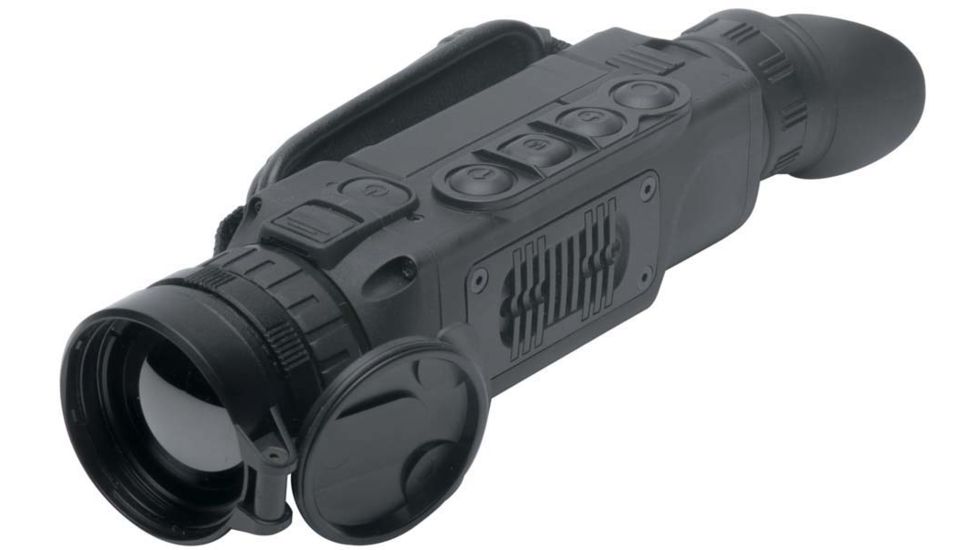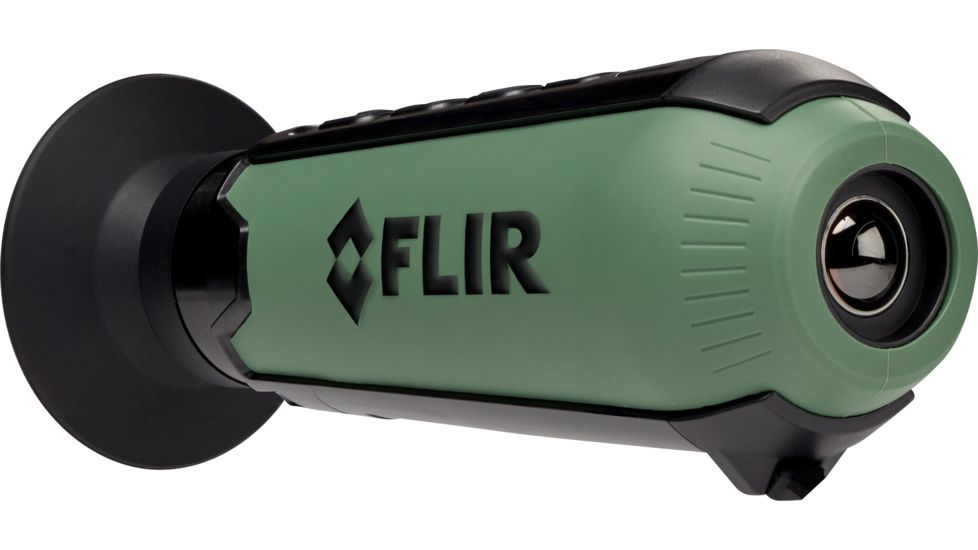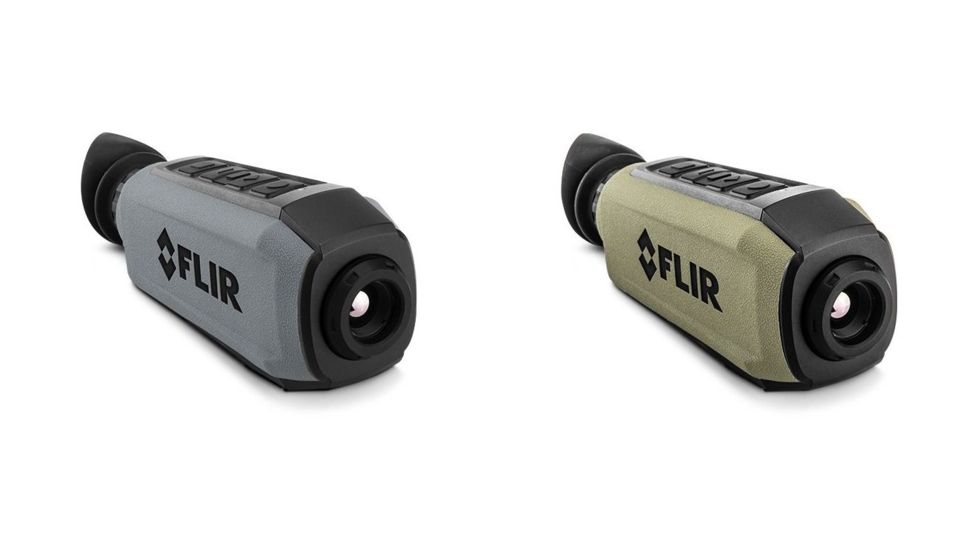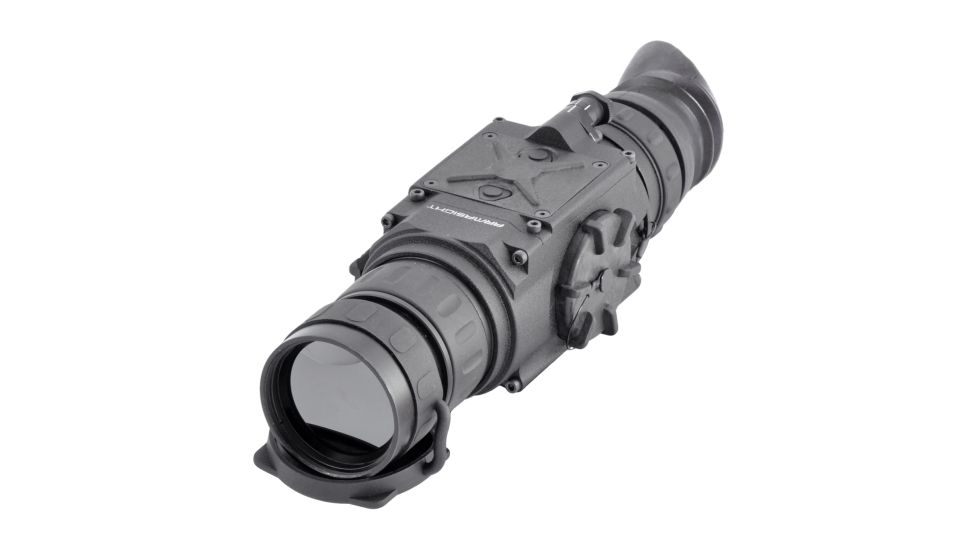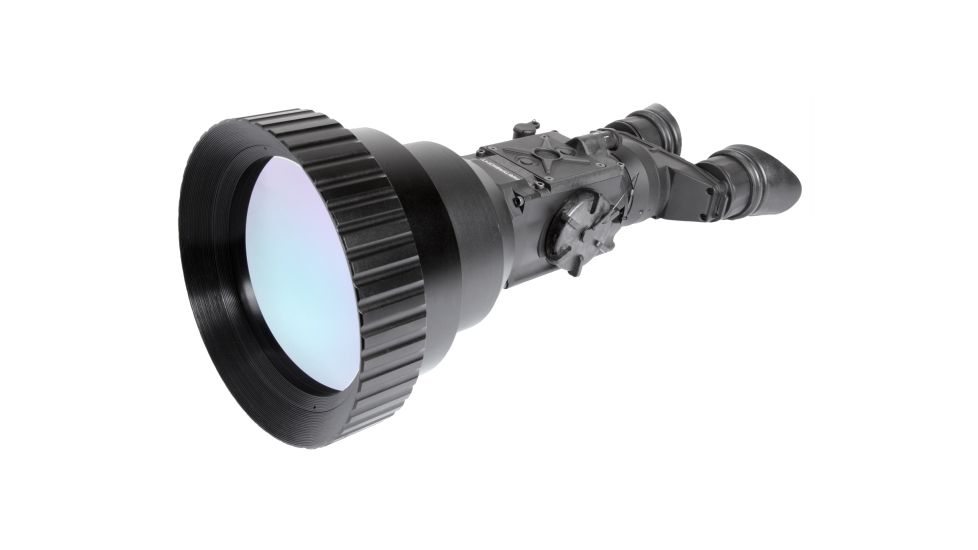With technology constantly improving today, it is becoming increasingly difficult to identify the best thermal monocular for indoor and outdoor applications.
In addition, there are many factors to consider when buying a thermal monocular.
Here is a comprehensive buying guide for you, containing in-depth reviews of some of the best thermal imaging monoculars on the market.
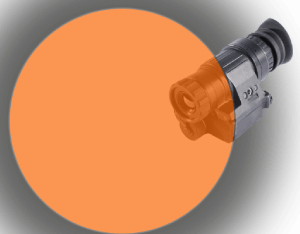
More...
Best Thermal Monocular Reviews - Our 10 Picks
Best Feature | Product Name | Price |
|---|---|---|
Really Close To Perfection | Pulsar Helion XP50 2.5-20x42mm Thermal Imaging Monocular | |
Best Detection Range | Pulsar Axion XM30 Thermal Monocular | |
The Cheapest in This List | FLIR Systems Scout TK Mini Thermal Monocular | |
A Superb Thermal Monocular | ATN OTS-HD 640 Thermal Smart HD Monoculars | |
User-Friendly | FLIR Systems Scion OTM | |
The Best Durable Monocular | Armasight Prometheus 336 3-12x50 Thermal Imaging Monocular | |
Good For Its Designated Purpose | FLIR Systems Scout III 240 Thermal Night Vision Monocular | |
Best Versatile Thermal Monocular | FLIR Breach PTQ136 Multi-Functional Thermal Imaging Monocular | |
A Solid, High-Tech Performer | ATN OTS-HD 384 Thermal Smart HD Monoculars | |
Best in Simplicity | Armasight Command HD 640 4-32x100mm Thermal Imaging Monocular |
Pulsar is one of the most renowned brands in thermal imaging & hunting gear market. Their high-quality products and impeccable approach to manufacturing established them as a leader in the space.
Their Helion line of thermal monoculars was always a well-recognized and well-received by buyers, and for a reason; they simply outperformed others, regardless if the product is used for hunting, surveillance, or search & rescue.
The latest Pulsar Helion XP50 2.5-20x42mm is a crown jewel of Pulsar’s manufacturing & approach to modern thermal imaging devices. It comes jam-packed with features, it’s solid as a rock, rigid and waterproof, while being decently light and very convenient to use.
Besides the 1800-yard detection range, 50Hz refresh rate is something that Pulsar products consider as a standard, and this feature really brings the fluid performance which is essential to precise usage & results at high distances.
Combined with the integrated accelerometer, stadiametric rangefinder, 640x480 resolution with 17 µm details and a frost-resistant display, and a big, easy-removable battery you get the clear picture about this product’s quality.
When talking about a product in this price range, you want all the tech gizmos to accompany the ruggedness & sheer quality, and Helion XP50 delivers. You get high-quality video recording & streaming, image recording of course, 8 color palettes to choose based on the environment and time of the day, and intuitive Stream Vision mobile app to enhance the control.
But, as always, it’s not all sunshine & rainbows with XP50. The above-mentioned app is both iOS & Android friendly, but it lags & behaves quite strangely on the latter. (We didn’t test on iOS yet) Furthermore, you can’t access certain functions if you don’t use a mobile app, such as delayed snapshots.
- High refresh rate & viewing distance
- Crisp image even on the biggest distances
- High-quality video recording & streaming
- Expensive
- Some features are only mobile-app-available
- The mobile app could be better
Final Verdict
Simply said, there’s no perfect product. But for a thermal monocular, Pulsar Helion XP50 2.5-20x42mm is really quite close. If you’re in the market for a high-quality thermal monocular and have money to spend, this is the one to get.
Thermal monoculars of Pulsar are selling like hot cakes thanks to their high-quality construction, rich features, and unexpectedly affordable pricing.
Take the Pulsar Axion XM30 Thermal Monocular, for example. This is the latest model in 2019, which is claimed by Pulsar to be perfect for exploring or night hunting. Let’s see why it is worth your consideration.
First off, the Axion XM30 is extremely compact, which weighs exactly, about 10.6 ounces. Thus, you can hang it around the neck or put it in your pocket at ease. The size is also comfortable for handling and gripping with your hand.
Secondly, this monocular is made of magnesium alloy to ensure high structural ruggedness and rigidity. Even better, the case is IPX7 waterproof. Such protection will lengthen the lifespan of the optics.
In terms of vision, Pulsar Axion XM30 supports a super-wide detection range: 1,300 yards with 12um px pitch core, a 50Hz refresh rate, a central resolution of 320 by 240, and an HD Amoled display at 1024 by 768-pixel resolution.
Plus, there are three high magnification powers, from 4x to 16px. The objective lens is Germanium. You can expect to scan and identify wild animals within 1,300 yards.
Also, multiple color viewing modes are available rather than only the black-hot or white-hot palettes in traditional models. Thus, you can optimize your vision into wildlife. Exciting enough, all buttons and settings are right at hand. You can shoot still pictures, record videos, or even stream those videos via the Stream Vision app.
Good as the monocular is, there are still some flaws to improve. For example, the button is somewhat small to distinguish while you are wearing a glove. In addition, the device heats up quickly while running.
- Affordable
- Lightweight and durable construction
- High magnification power
- Vivid color palette display
- Easy operation and settings
- Shooting and recording modes available
- Small navigating buttons
- Quickly heated up operation
Final Verdict
All in all, Pulsar Axion XM30 Thermal Monocular is too good to be true at its price category. The thermal optics performance is excellent, and the construction is high-quality.
First of all, FLIR Scout TK thermal monocular stands out due to its compact size, which makes it easy to store. Whether you are hiking through the woods or surveying your property, you can easily carry this monocular around since it only weighs 170g.
It packs hi-tech specs that boost the performance in poorly lit environments. This is one of the best cheap thermal monoculars on the market.
Scout TK thermal monocular is ideal for both indoor and outdoor applications.
It allows you to spot hidden prey by switching to monochrome mode letting you distinguish the hot whites and cold blacks in any environment. This improves visibility in low-lit environments significantly, allowing you to spot the prey better.
A built-in InstaAlert Feature facilitates quick spotting of prey in your hunting missions. The range, however, isn’t boast-worthy; quite the contrary, everything after 25-50 yards is basically unusable. Still, considering the price, it’s ok - you get what you pay for.
The multiple-color settings are a good addition to this setup, and are appreciated; still, don’t expect much from them.
FLIR Scout TK operates on Li-Ion rechargeable batteries that can give you 5 hours of undeterred surveillance. This feature is a bit exaggerated by the manufacturer, as this device won’t last as much. Furthermore, the battery can’t be user-replaced, so you have to carry a charger around, making it not as compatible.
- Quickly spots prey with Insta-Alert feature
- Performs well in low light conditions
- Virtually water and dustproof
- Range is on the shorter side
- Battery doesn’t last long, and can’t be replaced
Final Verdict
This is a handy little monocular, which can fulfill its purpose, which is short-range viewing & yard security. Its low price is one of its main pros, and it should be treated as such. Even it doesn’t have a plethora of functions or a long-lasting battery, it still brings value to the right person. And quite easily, you can be that person.
Starting with the best the ATN OTS-HD 640 has to offer, and its e-zoom settings come into play.
It enables the device to focus on very distant objects; HD 640 has the power to increase its magnification from a meager 2.5x to a massive 28x (depending on which version of the monocular you buy).
What’s more, since this unit runs on 4 AA batteries, it provides a considerable runtime of 8 hours on a single charge. ATN OTS-HD 640 comes with an upgradable firmware - that means you can update its antivirus at will.
The firmwares is making this device so potent; it is suitable for a wide array of environments due to its 3D gyroscope and E-compass features. While the 3D gyroscope – by reducing hand shake – stabilizes the image and provides crisp, sharp images, the E-compass feature lets you navigate your way.
More importantly, as we found out during our testing, using this product is effortless. ATN OTS-HD 640 has separate buttons for power switch, zoom increase/decrease plus a toggle as well. Equally impressive is the Smart Rangefinder feature, which allows this device to measure distances accurately.
Next comes the E-zoom feature which gives it the freedom to focus on distant objects, but not at the cost of clarity - this monocular provides the crispiest zoomed output on the market.
Turning our attention to the high-end features of this model, and its connectivity features come into play; Wi-Fi streaming mode, Bluetooth connectivity ensure synergy with modern devices which enrich the experience significantly.
Speaking of experience, the following ATN companion app is iOS & Android compatible, making this device even more straightforward & intuitive to use.
- Smart Range Finder
- E-zoom feature
- 3D gyroscope and E-compass increase its utility
- Upgradable firmware and Wi-Fi streaming
- Relatively small field of view
- Mediocre refresh rate
Final Verdict
Granted, the field of view of this model isn’t that large. But it isn’t on the smaller side, too. In fact, in this price range, not many thermal monoculars could rival the features of the ATN. It is a modern, high-quality monocular that will make you a better hunter, guaranteed.
If you’re looking for an all-around thermal monocular, you’ve come to the right place. After seeing what this product is capable of, you’ll hardly stay unbiased. Here’s the FLIR Systems Scion OTM.
As you probably know, some of the leading names in the hunting gear industry are ATN and Pulsar, but FLIR is right there next to them. They excel at dishing out premium products that are expensive but undoubtedly worth it, and this right here is one of them.
Before going into the specifics, let’s talk a bit about its design and use. It’s a handheld monocular set with an ergonomic look and beautiful design to it. It’s simplistic, comes in green and grey for camouflage purposes, and it’s relatively compact. All in all, it’s an excellent addition to your overall hunting set.
When it comes to the thermal imaging software, you can rest assured knowing that you’ll get a crystal-clear view of your prey within the viewing distance. The clarity is truly unique, and you can even calibrate the thermal palette with ease in the user-friendly menu.
Of course, this type of premium device will not leave you without some crafty additions. Firstly, it’s equipped with the latest WiFi and Bluetooth settings, enabling you to easily upload and transfer the data you record to your mobile or computer device.
It also comes with an accelerometer and compass, which is a huge bonus considering you won’t have to use your phone in cases where you require absolute focus and stability. All the data you need is relayed to the OLED display.
What’s incredible is that all these features do not drain the battery as one would think. If it’s used non-stop from the top, it’ll last you up to 4-5 hours. Essentially, that’s more than average for thermal monoculars.
The only hiccup is the price, which is truly an investment of sorts. However, if you choose to invest, you won’t regret a thing.
- Reliable manufacturer of hunting gear
- Ergonomic design with camouflage colors
- Good battery life
- Thermal imaging technology
- Clarity
- Additional features
- Premium price
The next monocular comes from Armasight, a manufacturer known for creating stable and durable products. As it turns out, this is also one of them. Here’s the Prometheus 336 3-12x50 Thermal Imaging Monocular.
Since we’re calling it one of the best thermal monoculars, what is it that makes it the best? Let’s talk about its build first. This model’s been manufactured with military applications in mind, which is why durability is the number one feature that makes this monocular stand out.
The entire monocular is a bit hefty, but it’s still ergonomic in its use. It’s made from aircraft aluminum alloy, and it passed the IP67 rating, meaning it’s waterproof and has advanced protection from fall damage.
In terms of specifications, there’s no doubting it - you’re in for a treat with this bad boy. As we could see, the Armasight thermal imaging software has proven to be one of the best on the market due to the clear distinction it creates in its visual rendering.
Whichever obstacle you have in the way, this software will let you see through it, even at a 500-yard distance.
Of course, we shouldn’t forget to mention that it has an integrated recording system that enables you to take videos and later rewatch them on a larger screen. Another great feature is the digital zoom that not all monoculars have. It’s available in 1x, 2x, and 4x without losing much of the quality as the picture enhances.
Due to lower resolution, which rests at 336x256, your image won’t be as clear as it would be with some thermal imaging riflescopes, but it does offer you a 30 Hz refresh rate, which is absolutely applicable for this type of resolution.
All in all, it’s a great device with an array of applications and not just military or hunting. If you’re not bothered by its size and heftiness, you should definitely try it because you won’t be disappointed. It’s a quality purchase without a doubt!
- Overall durability
- Armasight thermal imaging software
- Easy to use and user-friendly
- Three-year warranty
- Digital zoom
- 336×256 resolution
- Bulkiness
What is it that separates the Flir Scout III from other models in this review? For starters, its 1200-yard detection range (600-yard is its most effective zone), 640x480 LED screen and 240x180 thermal resolution – combined to give you high-quality detection.
Furthermore, the Flir Scout III comes with a refresh rate of 30Hz which produces a crisp image. That said, it isn’t the market leader in this aspect, as Pulsar goes as far as to offer 50 Hz refresh rate in some of their similarly priced models.
Moving on, this product provides a magnification factor of 2x and 4x and provides three different zoom settings in both 2x and 4x. Have in mind that these are provided by software, not hardware.
It also gives you the freedom to choose from a wide range of detection palettes including White Hot, Black Hot, Insta Alert and Graded Fire). This is a decent feature set, as it proves to be one of the key-performing factors in hunting in low visibility.
Scout III-240 provides two operation modes to give you the best picture for your environment. These include the E-zoom and color palettes described above. Have in mind that the E-zoom is a tech naming for an electronic (software) magnification, as this model doesn’t have a real zoom.
Battery timing is another strong feature of this model. For, despite weighing a paltry 12 ounces, its manufacturer has managed to find space to pack this unit with a market-favorite Li-ion battery. That decision has paid dividends as this model comes with a 5-hour battery timing.
- 1200 yards range
- 680×340 display screen
- Compact and lightweight
- Pricey
- No recording (have to use adapters & external recorders)
- No fancy tech & connectivity
Final Verdict
Thanks to its increased resolution, compact design and a plethora of useful features, the Flir Scout III 240 is undoubtedly one of the best middle-class thermal monoculars out there. Go for this model if you aren’t deterred by its price tag.
#8. FLIR Breach PTQ136 Multi-Functional Thermal Imaging Monocular - Best Versatile Thermal Monocular
Another excellent thermal monocular produced by FLIR. This time, we introduce you to a multiple-purpose monocular. It works as an optical device to capture objects from great distances. Or, you can mount this monocular into helmet mounts or head mounts, firearms, or additional equipment to record things.
To do so, this FLIR Breach PTQ136 features a durable construction of polymer, rated with an IPX7 waterproof body. It is also compact to be concealed in a pocket. Even when you attach the mini-rail mount, the total weight is just around 7 to 7.5 ounces.
The image through this monocular is exceptionally clear. There is a 320 by 356 micro-bolometer 60Hz rate, along with a built-in FLIR Boson thermal electromagnetic spectrum. Such specifications feature a more precise image despite a narrow detection range.
Specifically, the device comes in 7 visual schemes, including Black Hot, White Hot, Iron bow, Rainbow HC, Sepia, Outdoor Alerts, and the Arctic. Such a wide range of color options makes it easy to detect and record onboard. Most impressively, the FLIR monocular can detect IR signatures as small as pests if they are in the range.
1280 by 960 display of Quad-VGA FLCO supports output for digital videos by using the USB connection available on the shell. This display screen is brightly vivid without having to use an eyecup or additional accessories.
However, do not expect to get an astounding view in low light environments such as in a dense forest or grassland. This optical tool fails to recognize bland images where there is a similar spectrum of IR light.
When it comes to the power source, this FLIR Breach is powered by a CR-123A battery. Thus, it lasts for 4 hours without recording. You can also charge the tool with external devices through the Type-C connection.
- Super lightweight body
- Multiple usage thanks to mini-mounted rails
- Various visual schemes
- Hand-free operation
- Expensive
- Not too clear in low-light conditions
- Short detection range
Final Verdict
Although the FLIR Breach monocular is a bit more expensive, it is still worth buying thanks to the quality construction and multi-purpose designs and functions. Give it a try, and you will see.
This monocular belongs to ATN’s range of thermal imaging cameras which boast of an OTS-HD Obsidian core processor. The hi-tech processor makes the monocular super fast and less lagging whether it's closing in on your prey or recording the entire experience.
ATN OTS HD 384 thermal monocular features a compact lightweight design. Most of the inbuilt functions are controlled by a touch of a button. The monocular also comes with smart features to increase accuracy and reduce guessing while hunting.
A built-in smart rangefinder allows you to bracket your target with two clicks and a shift of the scope. The reticle automatically adjusts to provide an accurate point of impact. In addition, a smooth zoom feature helps you close in on your subject with minimal lag.
The ATN OTS HD 384 also comes with Bluetooth and Wi-Fi features. It connects to a smartphone or tablet via convenient ATN Obsidian mobile app. This allows you to connect to an even bigger screen and view the action both on the scope and mobile device.
You can take HD images or record HD videos on the ATN OTS 384 thermal monocular. It has a 1080p video recording capacity while the obsidian core processor facilitates fast image capturing in hunting action.
Speaking of fast image capturing, the device does come with sub-par refresh rate compared with other top-notch features. This means that a bit quicker movement will result in blurry, shaky footage. Same goes with magnification - everything beyond 50 yards will start to get pixelated & grainy.
Furthermore, ATN’s customer support is not really effective - if you happen to deal with them, expect very pleasant conversation, but very long waiting times. Worth noticing when purchasing a product in this price range.
- Built-in smart rangefinder
- Smooth zoom feature
- Built-in Bluetooth and Wifi
- 1080p video recording capacity
- Refresh rate is low
- Slow utilization of customer support
- Grainy & shaky footage while zoomed
Final Verdict
Even before you look at its other features, the presence of a built-in smart rangefinder and a smooth zoom feature elevates the utility of this model to a higher level. Considering its flaws (which are minor, but noticeable) ATN OTS HD 384 is a quite good purchasing decision regardless in which position you’re in.
Finally, the product we’ve been saving for the end is not bad at all, even though its position might indicate otherwise. The reason we’ve placed it here is that it’s relatively new and untested, but it still shows some remarkable potential. Without further ado, here’s the Armasight Command HD 640 4-32x100mm Thermal Imaging Monocular.
It is evident that the essential qualities that a monocular should possess rest upon the visual internals. In this model’s case, its prowess lies in optical lenses made with military applications.
These lenses made from Germanium enhance the overall capabilities of the monocular and improve its range performance. When you mix it with the fact that this monocular has a 640x512 resolution, you get one great thermal scanner.
When you go into the detailed description of this device, you’ll run into many numbers that’ll make your head hurt if you’re not acquainted with the terminology. What you must remember, though, is that this monocular is incredibly easy to use and set up.
The controls are intuitive and dedicated buttons are there to ensure you don’t get confused along the way. Also, the menu is electronic and offers multiple selections in a user-friendly fashion.
If you compare its size with some of the previous monoculars that we reviewed, you’ll come to the conclusion that it’s quite compact and doesn’t pose a problem on the field.
The thermal imaging software is one of Armasight’s proudest designs that’ll enable you to orient and focus on your prey without worrying about environmental effects that could potentially cloud your vision. Whether it’s rain, fog, dust, or night time, you’ll find the path to your target.
The only thing that seems to be problematic regarding this monocular is the overall battery life. It’s decent enough, but it’s not as durable as is the case with the FLIR Systems Scion OTM. Nevertheless, it’s an amazing monocular that you should at least check out.
- Germanium-made lenses for efficiency
- Easy to use
- Intuitive software
- Thermal imaging prowess
- Overall battery life
10 Key Factors that Should Affect Your Thermal Monocular Choice
Thermal monocular devices are used by firefighters, law enforcement personnel, hunters, rescue workers and in various other fields. These devices detect the presence of humans and animals by mapping a heat signature.
Many monocular models are available on the market, making it hard for you to narrow down to the one that is right for you. This guide lists the key factors that should affect your choice and help you find a monocular that fits your needs.
#1. Intended Use
The most important factor to consider when buying a thermal monocular is its intended use. Do you intend to use the device for nighttime (hog or other animals) hunting? Is the monocular intended for scanning the premises of your home to ensure security? Or is it going to be utilized for other surveillance and scanning purposes?
Your intended use will determine what type of monocular will suit you best. For instance, a monocular for home security doesn’t need a significant detection distance.
But when you are hunting outdoors and using a monocular, you will need a good detection distance in order to discern the target precisely.
So you should determine the detection range, weight, magnification, resolution and other details of the monocular depending upon its ultimate usage.
#2. Easy to Operate
Ease of use is important when it comes to a thermal monocular. This is simply because you will potentially use the monocular in sensitive situations such as hunting, surveillance and home security. So, you want the device to operate easily and offer quick navigation.
You may need to check out different models to see which one feels most intuitive to you. The ideal monocular will be one which has conveniently placed controls that are easy to manipulate and let you tweak the relevant settings quickly.
#3. Weight
The weight of a monocular device is a very important factor. When you are hunting outdoors for hours on end, a heavy monocular quickly becomes a burden.
So if you intend to use the monocular extensively, you should go with a more light-weight model. However, you may need to compromise on this factor.
Lighter monocular models are available but they often lack the advanced features that heavier models offer. So you may have to strike a balance between performance and weight in order to find a monocular that’s best-suited to you.
Thermal monocular devices are typically used outdoors. This is why they must also offer good mobility. A monocular that can be easily carried around and stored is perfect for use during hunting, surveillance, home security and other purposes.
In most cases, you may need to switch quickly from regular view to thermal scanning view in order to locate targets or potential threats.
A monocular with good mobility allows you to make the switch with ease and speed. Mobility also ensures that the monocular can be carried and stored without spending a lot of time.
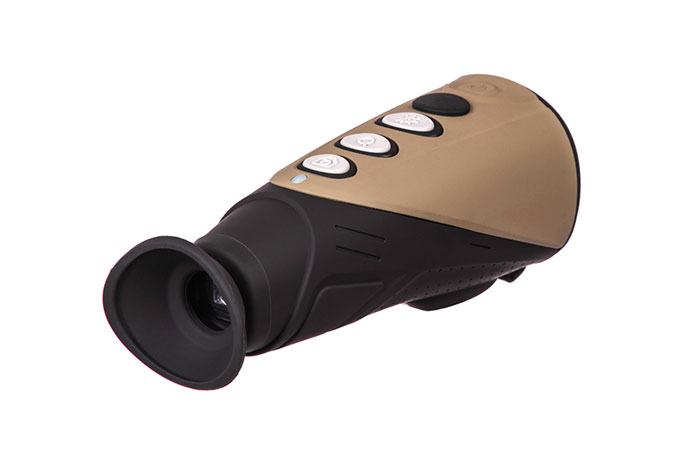
#4. Detection Distance
The detection distance of a monocular is usually identifiable from its magnification power. A monocular with a larger magnification power can enlarge a distant shape or image to a greater degree. This enables you to see a distant image more clearly and discern more details.
A smaller magnification power means that a monocular can enlarge and make clear an image over a smaller distance. So it has a smaller range of effective imaging.
Have in mind the performance of the monocular when zoomed to the max; if a product you’re considering pixelates & blurs the image on max zoom, it is basically useless on that range. Always inspect the effectiveness & quality of the output a thermal monocular provides before purchasing. This would be most important for hunters, but not as much for home security.
#5. Mobile-friendly
In many cases, you may want to store the imagery of a thermal monocular so that you can view and analyze it later. This is particularly the case if you use the monocular for surveillance purposes. Many monocular models come with support for mobile devices. Some even have an app that lets you directly stream the video from your monocular to a mobile device.
This is immensely useful especially if you are going to share the monocular data across a group or with friends or colleagues who are remotely situated.
It also allows you to stream the video and then store it on a device with sufficient internal storage space.
#6. Thermal Sensor
Most thermal monocular models come with Forward-Looking Infrared (FLIR) sensors. These sensors come in different degrees of performance. The metrics that indicate a thermal sensor’s performance usually read like 640×480, 160×120 and 320×240.
The thermal sensor is the most vital component of a thermal monocular. It is this sensor that detects the degree of heat emitted by various objects being viewed through the monocular.
The sensor then maps and displays the heat signature of these objects in varying degrees depending on the amount of heat emitted.
#7. Day and Night Mode
The great thing about thermal monocular models is that they come with both day and night vision modes. Thermal imaging relies on mapping the heat signature of a human or an animal in order to detect them.
This signature is then displayed as an image so that you are able to detect their presence. This mapping can be effectively done by thermal imaging in light as well as dark conditions.
You can choose a monocular that offers both modes or a model which offers the mode that you need. For instance, if you intend to use the monocular for nighttime hunting, you can settle with a model that only offers night mode.
If you are going to hunt during day, in foggy conditions as well as at night sometimes, a model that offers both day and night modes will be more suitable.
#8. Image Palettes
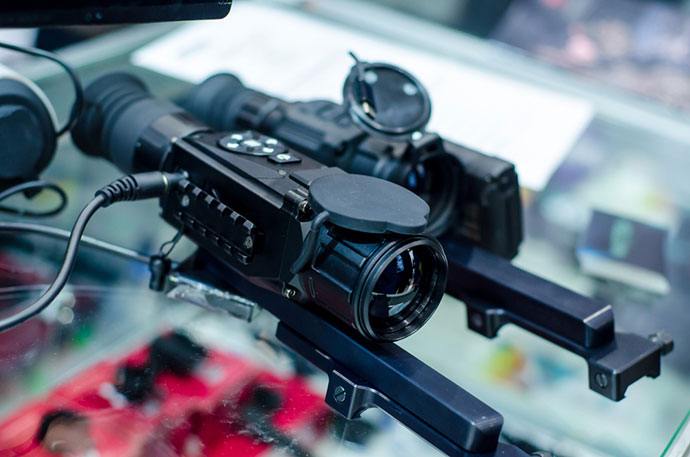
Color contrast is essential when you are viewing through a thermal monocular. It is the color contrast that lets you distinguish a heat-emitting object such as a human from a non-heat emitting object such as a wall or a stone. At the same time, a good color palette also offers distinction between objects with varying degrees of heat emission.
The White Hot palette is most commonly used in FLIR thermal monocular models. This palette displays warm objects in different degrees of white, against a dark background. The resulting view is very realistic and allows you to discern the details quite precisely.
The Black Hot palette reverses the image so that warm objects are shown in different shades of black against a white background. This is particularly useful for nighttime use. At times when the scene in front of you has a very low contrast, the Rainbow HC palette is the perfect choice. This palette uses a wide range of spectrum to display a thermal image with various colors.
The warmer an object is, the deeper is the shade of red it is displayed in. This palette is useful if you want to see small temperature differences vividly.
Yellow or Sepia is another color palette frequently offered in thermal monocular devices. This palette provides a contrast by using a yellow/black combination. Heat signature is shown in shades of yellow against a black background. This combination is particularly preferable if you are going to use the monocular for long stretches of time.
If you want the warmer objects to stand out clearly without requiring too much object detail, Arctic palette is a good choice. This palette uses a clear outline to distinguish cooler objects from warmer ones. Because it uses shades of blue for coolness and a kind of orange shade for the heat signature, it is aptly named Arctic.
You can choose a thermal monocular that offers a single or dual color palette. Alternatively, you also have the option of choosing a thermal monocular device that offers up to 7 color palettes. As a rule, the more color palettes you have, the better it is. This is simply because you are able to achieve good visibility and scanning in a diverse set of environments.
#9. Resolution
Resolution is the clarity of the image displayed by the monocular to your eye. If the resolution is high, the image is clearer and there is more detail in it. If the resolution is lower, the image is less clear and may become even blurry in the case of very low resolutions.
Typically, you should go with a monocular that offers higher resolution. However, exceptionally high-resolution monocular models can cost a tidy sum.
So be sure that you don’t go for the highest resolution, but a resolution that is high enough to serve the purpose for you. Thermal monocular resolution is usually denoted as 320 x 240 or 640 x 480.
#10. Battery
The power source of a monocular is an important factor. If you are going to use the monocular outdoors for many hours on end, you need a battery that can power up the monocular for so long without requiring a recharge. Monocular models usually come with rechargeable batteries or Lithium-ion batteries. You can choose between the two depending on your specific needs.
Monocular models that can run continuously for a longer stretch of time without requiring battery recharge or replacement typically cost more. You can circumvent this by choosing a device with rechargeable batteries or carry back-up batteries for emergency usage.
The thermal monocular that is a good fit for you depends entirely on your needs and requirements. You must clearly identify why you need the monocular and what do you intend to use it for. Once these questions are clear, it will be a lot easier for you to make the right choice.
Best Feature | Product Name | Price |
|---|---|---|
Really Close To Perfection | Pulsar Helion XP50 2.5-20x42mm Thermal Imaging Monocular | |
Best Detection Range | Pulsar Axion XM30 Thermal Monocular | |
The Cheapest in This List | FLIR Systems Scout TK Mini Thermal Monocular | |
A Superb Thermal Monocular | ATN OTS-HD 640 Thermal Smart HD Monoculars | |
User-Friendly | FLIR Systems Scion OTM | |
The Best Durable Monocular | Armasight Prometheus 336 3-12x50 Thermal Imaging Monocular | |
Good For Its Designated Purpose | FLIR Systems Scout III 240 Thermal Night Vision Monocular | |
Best Versatile Thermal Monocular | FLIR Breach PTQ136 Multi-Functional Thermal Imaging Monocular | |
A Solid, High-Tech Performer | ATN OTS-HD 384 Thermal Smart HD Monoculars | |
Best in Simplicity | Armasight Command HD 640 4-32x100mm Thermal Imaging Monocular |
Two Common Types of Thermal Monocular
1. Thermal Handheld Monocular
There are many different types of designs when it comes to thermal monocular devices. The most commonly used is the handheld monocular. This type of monocular is equally popular with hunters and outdoor enthusiasts.
Handheld monoculars are typically compact and nifty devices which can be easily carried around. They are also lightweight and do not become a burden. Handheld monocular devices also cost low most of the times.
On the downside, handheld monocular devices are a significant hassle if you have to use them for extended periods.
For instance, if you are doing surveillance on a building or a person and need to continuously use the monocular, it can become very tiring.
Storage of a handheld monocular can also be a slight problem. You can hang it from your neck like a chain or keep it in your pocket but in either case, you need to be careful about it especially if you are doing any physical activity such as running.
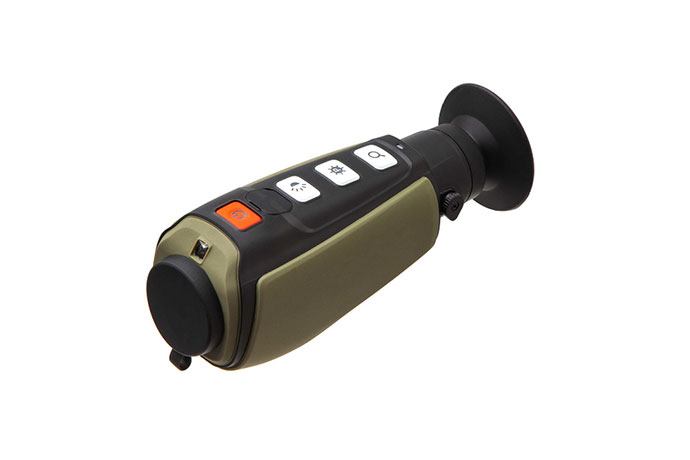
2. Thermal Monocular Head Mount
Another type of thermal monocular devices is the head-mounted devices. As their name suggests, these devices are used in combination with a headgear so that they are mounted entirely on the head.
You can use a quick switch to bring them in front or to remove them from the eye level. However, you don’t have to hold the device or use your hands for operation. The overwhelming benefit of a head mount monocular is that it frees up your hands.
You can use your hands for carrying or operating other objects, performing physical activities such as holding a weapon or climbing a wall, or for other purposes.
At the same time, the headgear keeps the monocular mounted with stability at the right eye level, giving you a steady thermal image. When mounted on a headgear, you also don’t have to worry about the storage of the monocular device.
A head-mount monocular is particularly useful if you are going to use the device for extended stretches of time. For instance, if you walking and scanning at the same time, or if you are performing surveillance and need to engage with a person at any time, the head-mounted monocular provides continuous surveillance while also allowing the freedom to multi-task.
On the downside, a head-mount thermal monocular usually costs more. You have to pay not just for the monocular but also the headgear equipment. It is also somewhat of a hassle to wear the headgear and you have to be careful not to damage the headgear or the monocular mounted on it.
FAQs
What is the best thermal imaging monocular?
Right now, the award for the best one undoubtedly goes to the Pulsar Helion XP50 2.5-20x42mm Thermal Imaging Monocular.
It’s efficient, compact, and ready to go at all times. Aside from that, it’s video-recording capabilities are unmatched by any of the products on this list, which is why it definitely goes to the number one spot.
What is the best thermal monocular for the money?
You can simply conclude from the pics of the FLIR Scout TK that it’s the budget pick.
It’s a pocket-version of a thermal scope that is not that impressive in specs, but efficiency is definitely its outstanding virtue.
Moreover, its compactness will not make you drop down your gun to stabilize it and get a better view - you can hold both the rifle and the monocular.
What are the best thermal binoculars?
Honestly, it’s hard to decide since ATN manufactures the best thermal binoculars, but there are so many models to choose from. If we absolutely had to choose, it would be the ATN BINOX 4T 384 2-8X Thermal Binocular.
It’s a simple-to-use product with a high definition display that relays the images at a 60 Hz refresh rate. What’s more to want?
How long until a thermal imaging monocular degrades?
In general, if you treat them with care, they could last you a lifetime, depending on how often you use them.
In general, they can endure 5000-10000 hours of use with ease.
Conclusion
The type of thermal monocular you decide to use is determined by your personal preferences and how you intend to use it. Whether you are hunting or simply surveying your environment, a good monocular should work well in both well-lit and poorly lit environments.
In addition, the best thermal monocular should easily zoom in and out even when in motion. Consider working with a lightweight monocular that you can carry around easily wherever you go without weighing you down.
If you want the best of the best, the overall winner is definitely the Pulsar Helion XP50 2.5-20x42mm Thermal Imaging Monocular. The sheer power & accuracy it brings are simply too good compared to everything else on the market.
Its only real flaw can be easily surpassed by updating the software of the app, and synchronising with the smartphone. In both range, clarity, responsiveness, refresh rate, usefulness, ruggedness & durability, and overall value, this monocular is the best one to get.

